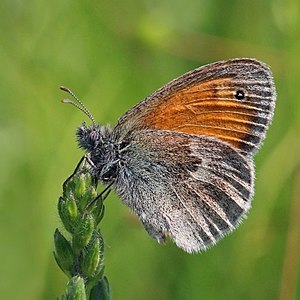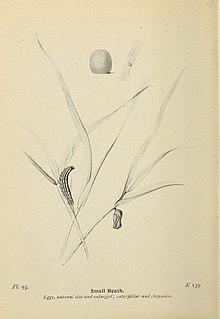Little meadow bird
| Little meadow bird | ||||||||||||
|---|---|---|---|---|---|---|---|---|---|---|---|---|

Little meadow bird ( Coenonympha pamphilus ) |
||||||||||||
| Systematics | ||||||||||||
|
||||||||||||
| Scientific name | ||||||||||||
| Coenonympha pamphilus | ||||||||||||
| ( Linnaeus , 1758) |
The small meadow bird ( Coenonympha pamphilus ) is a butterfly ( butterfly ) from the family of noble butterflies (Nymphalidae) and is also known as the small hay butterfly .
description
The moths reach a wingspan of 23 to 33 millimeters. They have brownish, ocher-colored or slightly orange upper wing surfaces with a not sharply demarcated, gray border and a faded, dark point near the tip of the forewing. The hind wing undersides of Coenonympha pamphilus are variable, white-yellow, gray or greyish in color and have an indicated light transverse band. The undersides of the forewings are more intense orange in color and have a white nucleus and light-rimmed black eye-spot near the wing tip, which can sometimes be absent or reduced.
The eggs are green and then yellow, depending on the age of the female. The caterpillars are about 18 millimeters long. They are light green, including the head capsule, and have a dark, light-lined longitudinal line on the back. They have another, easily recognizable, white line on each side. A small, pink tip protrudes from the end of the abdomen. The light green tumbler is very stocky and has one or two dark stripes on the wing sheaths, which are broadly lined with light.
Similar species
- Large meadow bird ( Coenonympha tullia ) ( Müller , 1764)
- Coenonympha rhodopensis Elwes , 1900
- Coenonympha thyrsis ( Freyer , 1845)
- Coenonympha lyllus ( Esper , 1805)
distribution
The Meadow Bird is widespread and common throughout most of Europe , but is absent in Orkney , Shetland , Northern Norway, Crete , where it is replaced by Coenonympha thyrsis , and the islands of the southeastern Aegean . It is replaced by Coenonympha lyllus in the Iberian Peninsula, with the exception of the northern part, in the Balearic Islands , Sardinia and in western North Africa . It is also found in North Africa, Turkey and the Middle East as far as Mongolia . The northern distribution extends to the Arctic Circle . In the vertical distribution, the moths reach a height of 2000 meters (Alps), in North Africa even 2700 meters.
Way of life
The little meadow bird is well adapted to the high temperatures of the open country and lives on meadows, pastures, poor grass with gaps or lanes and in other grassy places on embankments, path and field edges, sand and gravel pits or ruderal areas .
Especially at low temperatures, the larger males show territorial behavior. These territories are actively sought out by unmated females for courtship and avoided by already mated females. Smaller males with less chance of mating stay outside of these territories.
The females lay their eggs one by one on dry stems close to the ground in low-growing grass. The caterpillars develop at different speeds. The caterpillars can overwinter in each of the caterpillar stages and take a summer break beforehand. The animals pupate on plants near the ground.
Flight time
The moths usually fly in two or three generations (multivoltin) from February to November. In regions with unfavorable climates such as northern Scandinavia, Scotland and the high altitudes of the Alps, only one generation develops in summer. The appearance of the first generation and their number of individuals is very much dependent on the climate of the habitat.
Food of the caterpillars
Serve as a larval food plants Festuca ovina ( Festuca ovina ), bluegrass ( Poa pratensis ), and other Süßgrasarten the genera bluegrasses ( Poa ), fescue ( Festuca ), Agrostis ( Agrostis ), deschampsia ( Deschampsia ) anthoxanthum ( Anthoxanthum ), bristle grass ( Nardus ) Zwenken ( Brachypodium ), silver grasses ( Corynephorus ) cynosurus ( Cynosurus ) and grape oats ( Danthonia ).
Systematics
The little meadow bird was first described by Carl von Linné in 1758 in the 10th edition of the Systema Naturae as Papilio pamphilus . The type location is Sweden.
Synonyms
- Papilio menalcas Poda , 1761
- Papilio procris Geoffroy , 1764
- Papilio nephele Hufnagel , 1766
- Coenonympha pamphiloides Reakirt , 1866
Subspecies
Many subspecies have been described, but their status is unclear. Many authors also consider Coenonympha lyllus as a subspecies. However, the caterpillar on the Iberian Peninsula differs from the small meadow bird by a black instead of a green head capsule and the moths by a silver line on the outer edge of the underside of the wing. There are no known sympatric occurrences of the two taxa along the contact zone in northern Spain . The conditions in the Middle East are unclear and the pre-imaginal stages have not yet been described.
- Coenonympha pamphilus marginata Heyne , [1894]
- Coenonympha pamphilus orantia Fruhstorfer , 1908
- Coenonympha pamphilus scota Verity , 1910
- Coenonympha pamphilus australis Verity , 1914
- Coenonympha pamphilus barcionis Verity , 1926
- Coenonympha pamphilus centralis Verity , 1926
- Coenonympha pamphilus londinii Verity , 1926
- Coenonympha pamphilus fulvolactea Verity , 1926
- Coenonympha pamphilus centralasiae Verity , 1926
- Coenonympha pamphilus infrarasa Verity , 1926
- Coenonympha pamphilus juldusica Verity , 1926
- Coenonympha pamphilus ferghana Stauder , 1924
- Coenonympha pamphilus nitidissima Verity , 1926
- Coenonympha pamphilus asiaemontium Verity , 1926
literature
- Hans-Josef Weidemann: Butterfly. Observe, determine. Naturbuch, Augsburg 1995, ISBN 3-89440-115-X .
- Günter Ebert, Erwin Rennwald: Tagfalter II (= The butterflies of Baden-Württemberg. Vol. 2). Ulmer, Stuttgart 1993, ISBN 3-8001-3459-4 .
Individual evidence
- ↑ a b c d Heiko Bellmann : The new cosmos butterfly guide. Butterflies, caterpillars and forage plants. Franckh-Kosmos, Stuttgart 2003, ISBN 3-440-09330-1 , p. 198.
- ↑ a b c d e f g h Martin Wiemers: The genus Coenonympha HÜBNER, 1819, in Europe: systematics, ecology and protection (Lepidoptera: Papilionoidea: Nymphalidae: Satyrinae) . In: Society for Butterfly Protection (ed.): Oedippus . No. 25 . Pensoft, June 30, 2007, pp. 1–42 ( european-butterflies.ufz.de [PDF; accessed on June 23, 2012]).
- ↑ a b Tom Tolman, Richard Lewington: The butterflies of Europe and Northwest Africa. Franckh-Kosmos, Stuttgart 1998, ISBN 3-440-07573-7 , p. 238.
- ↑ Markku Savela - Lepidoptera and some other life forms: Coenonympha pamphilus Lineaus, (1758)
Web links
- Lepiforum Taxonomy and Photos
- Moths and Butterflies of Europe and North Africa (English)
- www.schmetterling-raupe.de
- www.eurobutterflies.com (English)
- Coenonympha pamphilus at Fauna Europaea


